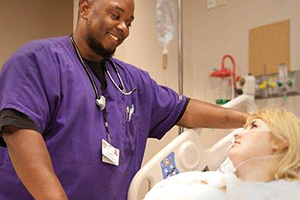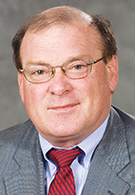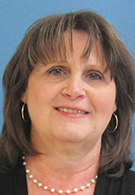By RENEE STOVSKY
James Ray, 35, a nurse's aide at CHRISTUS St. Michael Health System in Texarkana, Texas, says he is a people person and a "toucher" by nature. In the 13 years he has worked at the hospital, his routine always has included talking to his patients, praying with his patients and most of all touching his patients.

James Ray, a nurse’s aide, uses touch to reassure and assess his patient.
"I just have a habit of holding people's hands; I think it brings a lot to patients' hearts," he says. "They know that I care, and that I consider it a privilege to work with them here."
Since 2013, Ray has been one of almost 1,500 caregivers — registered nurses, licensed vocational nurses and certified nurse aides — throughout the CHRISTUS St. Michael Health System, including the hospital and 12 independent long-term care facilities, to receive "touch rounding" training.
The training, created in collaboration with the University of the Incarnate Word Ila Faye Miller School of Nursing and Health Professions in San Antonio, focuses on early warning sign recognition of patient deterioration related to heart failure, respiratory failure, sepsis, urinary tract infection, low blood sugar and other conditions.
First, trainees learn to quickly detect status changes in patients by practicing in simulation center sessions using mannequins programmed to demonstrate symptoms of the targeted conditions. They learn how to enter observational information into mobile tablet devices. The devices are equipped with clinical decision support software designed to assist users in flagging and urgently heeding signs of potential health complications.
First alert
Ray's training came in handy within a matter of months, when he walked into a patient's room, touched her hand and immediately suspected something was wrong.
"The patient was surrounded by her family, and they didn't realize anything was wrong. But her hand felt warm to me, so I quickly took her temperature and saw that it had risen to 101.2," says Ray. "Then I determined that she had an elevated heart rate, and she seemed confused."
Ray entered his clinical observations into the touch rounding software on his iPad and he called a registered nurse. By the time the nurse responded, Ray had concluded that the patient was showing signs of sepsis. The nurse concurred, briefly spoke with a doctor by phone and paged a rapid response team.
"The patient was treated, did fine and was discharged later that week," Ray says. "And I felt really good that I was able to catch something like that so early."
Extra eyes, ears, hands
That kind of outcome is exactly what Dr. Mike Finley, vice president, chief medical officer, at CHRISTUS St. Michael Health System, had in mind when he developed both touch rounding training and its complementary software, called SymCheck.

Finley
"My goal was to develop a program that could help caregivers function better as team members to provide a safer environment of care for our patients," he says. It naturally follows, he adds, that such a program could not only save lives, but also decrease hospital readmissions and reduce hospital costs.
Like most hospitals, he explains, CHRISTUS St. Michael has a hospitalist program with doctors who work on shifts, coming and going throughout the day and night. "All our bedside caregivers interact much more with patients, so empowering them to critically assess those patients in less than a minute — no matter what they are in the room doing — helps them become the eyes, ears and fingers of those doctors," he says.
Touch rounding is actually the end result of two grants CHRISTUS St. Michael has received. One, says Patsy Minor, project management nurse support specialist, was a six-month grant, funded in 2012 by a local group interested in improving quality of care, which allowed Finley to develop the SymCheck app in collaboration with an Austin, Texas-based software company. The other, a three-year innovations grant from the Centers for Medicare and Medicaid Services, was awarded in 2012 to fund the nurses' training program.
First impressions
Finley emphasizes that touch rounding is not the same as vital signs rounding. "It is literally a one-minute bedside assessment that can be done simply by touching the patient," he says. "In that 60 seconds, you can determine whether that patient's pulse is fast or slow, whether his or her blood pressure is regular, and, by noticing whether the skin is warm and dry or cool and damp, whether fever is present." At the same time, he adds, by talking to the patient, caregivers can assess mental status and note whether the patient is having any difficulty breathing, and do so without counting respirations.

Minor
"That one-minute assessment should either reassure the caregiver that the patient is okay or alert them to explore symptoms through SymCheck and quickly call RNs or rapid response," he says.
SymCheck, he adds, focuses on nine triggers that patients may complain about, from chest or back pain to headache, shortness of breath and pain in one extremity. Every time a nurse enters a complaint, it dynamically changes the outcome list of diagnoses, such as stroke or heart attack, and tells the nurse what course of action should be taken. "The more information you enter, the more SymCheck narrows possibilities by probability," says Finley.
Five Ps
During each caregiver's four-hour training session, adds Minor, participants learn to think about touch rounding through the five "Ps":
- Asking a patient whether he or she is having any pain
- Asking if he or she needs to use the bathroom (potty)
- Checking the patient's position
- Checking to see if call buttons and personal items are within the patient's periphery for easy reach
- Pausing to see if the patient has a question for the caregiver
Finley says the reaction to touch rounding has been very positive from both caregiver and patient point of view. "Surveys of trainees show the highest level of satisfaction," he says. "Nurses are incorporating it into their repertoire, and doctors like the higher level of communication they get during phone calls. One senior surgeon told me recently that in the last month, rapid nursing response has saved two of his patients' lives," he says.
Patients, Finley adds, are equally enthusiastic. "Patients are human beings in distress, ill and afraid. Touching, talking and comforting are just part of compassionate caregiving," he says.
The CMS grant expired June 30 and exact results on hospital cost reductions and mortality are still to come, but Finley says preliminary numbers show there has been a 50 percent reduction in harms in the hospital and a 10 percent reduction in cost per case.
Moreover, the SymCheck app has been submitted to the U.S. Food and Drug Administration for approval, and in October parent company CHRISTUS Health of Irving, Texas, is planning to begin touch rounding training at three San Antonio hospitals — CHRISTUS Santa Rosa–New Braunfels, CHRISTUS Santa Rosa Hospital–Westover Hills, both part of the CHRISTUS Santa Rosa Health System; and University Health System, a CHRISTUS partner.
"In the end, touch rounding is a simple tool that can help enable nurses to get their patients the best possible care, and to help doctors do really good jobs," says Finley.
Copyright © 2015 by the Catholic Health Association
of the United States
For reprint permission, contact Betty Crosby or call (314) 253-3477.